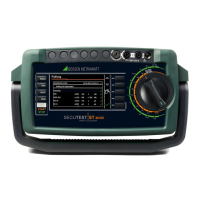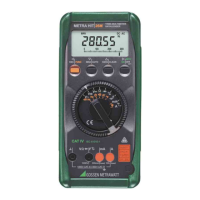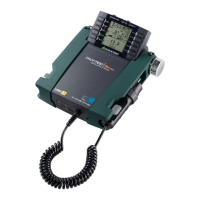GMC-I Messtechnik GmbH 17
5.4.1 General Procedure for Creating Test Structures
After selection with the MEM key, all setting options for the cre-
ation of a tree structure are made available on three menu pages
(1/3, 2/3 and 3/3). The tree structure consists of structure ele-
ments, referred to below as objects.
Selecting the Position at which a New Object will be Added
➭ Use the or key in order to select the desired structure
elements.
➭ If a sublevel exists, you can switch to it by pressing the key,
or you can open a branch.
➭ The open branch is then closed, or you can switch to the next
higher hierarchical level, by pressing the key.
Creating a New Object
➭ Scroll to the second menu page (MEM 2/3) with the help of
the key.
➭ After pressing NEW, a new object or DUT can be created. De-
pending on the current position within the hierarchy, the re-
spectively available object types are suggested. Depending
on the object type, you’ll have to enter at least an ID number
via the keyboard. If not all of the mandatory entries (identified
in red) are completed, an error message appears.
➭ Then press the green checkmark in order to accept the
entered values. The display jumps back up to the higher
hierarchical level.
Changing the Description or ID Number of a Previously Created
Object
➭ Scroll to the first menu page (MEM 1/3) with the help of the
key.
➭ Select the structure element whose designation will be
changed.
➭ Scroll to the second menu page (MEM 2/3) with the help of
the key.
➭ Press the EDIT symbol.
➭ Select the parameter whose description will be changed.
The keyboard appears automatically.
➭ Change the displayed designation and acknowledge your en-
try.
5.4.2 Searching for Structure Elements
➭ Scroll to the first menu page (MEM 1/3) with the help of the
key.
➭ Mark the structure element from which the search will be
started.
➭ Scroll to the third menu page (MEM 3/3) with the help of the
key.
➭ Press the text symbol in order to search for text.
➭ Press the ID symbol in order to search for an ID number.
There are three ways to enter search terms:
– Via the softkeys
– Via a connected USB keyboard
– Via barcode or RFID scanner
The keyboard entry function is opened automatically in any case.
➭ The search is started after the entered search term has been
acknowledged.
Only exact matches are displayed: no wildcards, case
sensitive.
The found object is displayed inversely.
➭ The designation and ID number can be shown or hidden by
pressing the magnifying glass symbol.
5.4.3 Displaying Measured Values from Saved Tests
➭ Switch to the database view by pressing the MEM key.
➭
Scroll to the first menu page (
Navigation)
(MEM 1/3) with the help
of the key.
➭ Either select the desired DUT (ID number) with the scroll keys
or search for it as described in Section 5.4.2.
➭ Then mark the desired test with the cursor, depending on
whether single measurements or test sequences are involved:
Single meas.: date / measuring function (7/17/14 / RISO)
Test sequence: date / test standard (7/17/14 / VDE...)
➭ In order to view the single measurements of a test se-
quence after testing, press the symbol for executed
measurements. The measurements appear in a list.
➭ Select the desired measurement with the scroll keys.
➭
The associated measuring parameters can be shown or
hidden using the keys shown at the right.
➭ The measured value view is exited by pressing the
green checkmark.
5.4.4 Backing Up and Restoring the Database
Any database created in the test instrument (structure and mea-
surement data) can be transmitted to a PC via the USB port and
saved with the help of ETC software.
Alternatively, the database can be saved to a USB flash drive (FAT
formatted, not NTFS) which is plugged in directly to the USB mas-
ter port at the test instrument (see SETUP 1/3 > Database >
Backup).
During data backup via the USB port (USB connection to
the PC or inserted USB drive), neither the interface cable
nor the USB drive may be disconnected. If the USB drive
is removed during the backup it may be rendered defec-
tive.
The test instrument may not be disconnected from sup-
ply power during data backup via the USB port.
Restoring the Database – RESTORE
If the database in the test instrument has been inadvertently
deleted, a database version which has been saved to the PC
(ETC) or a USB drive (FAT formatted, not NTFS) can be restored
to the instrument.
Restoring a database from a USB drive is only possible if the
firmware revision level is unchanged. If the firmware has
been updated between backup and restoring, the data-
base is no longer valid and cannot be used.
Data can be restored from an ETC database even after a firmware
update.
5.4.5 Deleting the Database
The database in the test instrument can be deleted in two differ-
ent ways:
• SETUP switch setting, page 1/3 > Database > Delete
• Press the MEM key > scroll up with the scroll key until the
database is selected > press the DEL softkey.

